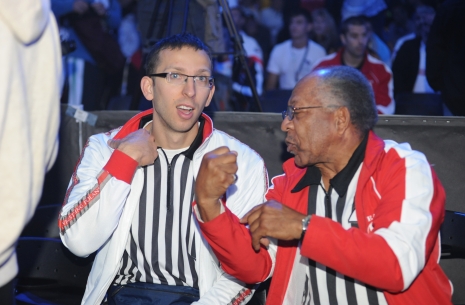
Is it worth it to use video recording of fouls on professional tournaments? Is there such a thing as a microfoul? Can a camera replace the referee? What do the competitors thing about this topic? ()
Khadzymurat Zoloyev is wholy against a system of recording the fights with video cameras.
The participants should be able to prove themselves and fight - says the sportsman - and in how many cases on the World Championship, how many great competitors, with whom others won only through fouls. I think that the best solution in such cases are highly qualified referees, who in the case of a dispute will be able to quickly make a decision.
Rustam Babayev also supports qualified referees, although he's not bothered by the recording of fights.
Video recording should be everywhere, but to determine fouls, qualified referees are needed, referees who in their times were competitors too - says Babayev. - These people really feel the situation, they know, when to give a foul, and when it's not necessary. For microfouls, which really don't affect the score of the fight and don't help you win at all, there should be no punishment.
Such a referee with a competitor's experience is Dariusz Groch, who will be a referee in this year's Nemiroff World Cup. What's interesting is that for him, first of all, there's no such thing as a mircofoul.
A foul is a foul and the rules are simple! - briefly comments Groch.
Groch also has a settled opinion about the work of the video cameras.
I would restrict the work of the video cameras to situations when there's a dispute, and I'd let the referees who know their work do their thing - thinks Groch. - Because those with the most experience do it in such a way that neither the competitor, nor the spectator, has any doubt what has happened, and most importantly they don't have any dispute regarding the verdict. The work, gesturing, behavior and reaction time of the referees can by themselves be interesting for the spectators.
Sometimes the referees, as well as the participants, are not able to unambiguously confirm that what they'd seen had an impact on the fight which took place before their eyes.
I'm not able to tell which foul had an impact on the fight - thinks Groch. - For example, whether by lifting his elbow half a milimeter a competitor hasn't saved himself from losing control in the wrist. The rules of armwrestling are very simple, the only problem is that most of the time they're useful when two competitors representing similar level meet, and that's probably mostly why they were invented. And it's exactly these most even fights which are the most interesting for the spectators and most pleasant for the competitors. And the referee, who does his job because he caught a foul - doesn't stop the fight because that's how he likes it. He does it because those are the rules. The competitor should only be upset with himself because he wasn't focused and prepared enough.
Iza Małkowska



Archive >>>
Vadim Akperov: "What I saw at A1 is indescribable"
Armwrestling World Championship 2013 - an attempt to sum up
Sławomir Głowacki: "I always feel like a winner"
Terence Opperman: “Cyplenkov is unmatched by anyone”